|
|
|
Oberlin, 2011
Friday, May 27 2011
location: rural Hurley Township, Ulster County, New York
Gretchen and I set off for the Oberlin reunion today, driving up to Albany and catching a flight to Cleveland. We were only in the Albany airport for a very short time, most of which we spent eating McDonalds french fries ($2.69) and pasta and cooked green beans from Villa Fresh Italian Kitchen ($12). We were just finishing up when the gate paged us to give us personalized final boarding calls. Ours was a small jet (one of those with A-aisle-BC seating), and the flight only took about an hour and a half.
It was mostly-cloudy and surprisingly cool in Cleveland. Walking in from the gate, Gretchen made mention of how rundown Cleveland-Hopkins airport is (particularly at the gates and in contrast with the airports in Albany, Rome, and even Newark). We lacked other transportation options, so we caught a cab to Oberlin ($55, about the price of our cab ride from Montepulciano to Chiusi, for the 25 mile ride). Our cab driver was a talkative Middle Easterner, though his banter seemed manipulative. He told us that Oberlin students are much nicer than students at John Carroll University, and then proceeded to tell us about the times that John Carroll students fled into the neighborhood instead of paying their fare. He also told us the tale of a couple he'd driven to Pittsburgh, one of whom claimed to have lost the voucher he'd been given to pay for the ride. At some point Gretchen brought up Darwin, which is almost never a good idea when talking to ordinary people, and sure enough our driver turned out to be a creationist. He most certainly did not believe that humans had evolved from monkeys, wondering (if that were true), why monkeys still exist. I tried to explain that monkeys are technically our cousins, but what was the point? The ride ended unpleasantly when the driver groused about our insistence on paying with a credit card (but we'd seen a sign at the airport saying that if a credit card is refused, the ride is free, which would have been awesome).
We had our cab drop us off at the alumni sign-in area, a piece of urban redevelopment on College Street a couple blocks east of the intersection with Main Street. This area had been so completely redeveloped, it was difficult to remember what it had replaced. There had maybe been a few conventional houses with small businesses, but now there was a whole new street lined with tidy aluminum boxes reminiscent of new architecture in Portland, Oregon or perhaps pre-bust Reykjavik. There were a number of cafés and other businesses spilling out into a pedestrian area, the likes of which Oberlin never had when we were students.
After Gretchen signed us in, we went walking westward down College Street towards campus, went south down main to the Feve coffee shop (it's still there) and back, and then continued west. A couple things immediately struck us as differences from the way Oberlin was back when we were students. The first was the profusion of new adult-friendly restaurants. For example, there appears to be a genuine burrito bar that serves actual margaritas. And there's a Chinese restaurant that has pad thai on its menu and stocks an impressive array of wines. By contrast, when we were students, Oberlin was still effectively a dry town. You could buy weak beer at Gibson's or the convenience store and drink beer (only beer) at the Tap House, and the only wine or hard liquor was at the Oberlin Inn. If you wanted something else, you had to brew it, distill it, or drive to some place out of town and buy it (I did all three). Now, though, you can buy a $5 bottle of vodka at Gibson's (which used to mostly be a bakery). Gibson's also sells things like deodorant, crackers, tampons, and even packages of prepared Indian food. Our attitude at seeing all this wealth of retail options was bittersweet. On the one hand, it was good that Oberlin matured out of the primitive retail environment we had known if only so we could benefit from it now. On the other hand, it was easy to view present Oberlin students as spoiled. Could it really be the same old Oberlin if alcohol, cappuccinos, and burritos could be had so easily?
We continued past the conservatory, which appeared to have a whole new wing clad in space-age aluminum, to the dorm where we first met, Harkness House. Aside from a new wheelchair ramp, Harkness looked much as it always had. There was even a little chalk graffiti on its front façade. The door was propped, so we went inside and, wow, it was a disaster. Superficially, it was clean, but the grunge of another year remained in the threadbare industrial carpet in a way that suggested that, say, the five second rule did not apply. There was also a smattering of graffiti on the lounge-area walls in places where it wouldn't have been tolerated in past years. Even the iconic mural of three Victorian women and a ram had been defaced (the mural now included a plump octopus and a crude attempt had been made at recoloring the ram). Beyond issues of surface nastiness, though, there were a number of holes in the wall and cracks and corrosion had begun to appear in the entranceway staircase. Still, the essence of Harkness was still there; it was easy to pinpoint the place in the lounge where Gretchen and I had first met back in August of 1988 (as part of an orientation exercise wherein we coupled our names with alliterative adjectives).
Down in the dining room, we found the nasty old carpet had been replaced with linoleum tile (carpet had always seemed like a bad idea there). It was possible to get into the kitchen, where we found minor rearrangements and replacements of the equipment. For example, the Hobart bread mixer was smaller. We were distressed to find that now there is a "gluten free" dry foods room. (Traditionally Harkness has been more resistance to dietary fads.)
In the the distant parts of the basement, we found that the two bathrooms had been completely remodeled to accommodate the handicap, though graffiti had sprouted up like a ghetto palm to festoon just like the good old days. We found that mechanical room (where Gretchen and I used to hang out) had been expanded to include a neighboring storage room. Unfortunately, the door was locked (and I didn't have the time or information to whittle out a key).
We went upstairs to the second floor of Harkness, the floor where we used to live. The carpets were nasty up there too and included a few body outlines executed in tape (as one would see in a television cop drama). We happened to be there when a young man went into Harkness 201, the room where I lived during my Junior year and the place where Gretchen and I first kissed. So we insisted on coming in and looking around. The kid was a jazz horn player in the conservatory and was happy to let us look around, though his room (like the rest of Harkness) was a wreck, partly as a consequence of the things that happen after several forties and a two litre bottle of Popov vodka get drunk.
As alumni for the 20th Reunion, we'd been assigned a room in Burton Hall up on North campus. As we began our walk in that direction, we came upon a gentleman from the class of 1992 with a long mohawk-mullet. He was dressed in a kilt, and he defied no stereotypes when he said he'd been a member of Keep Co-op. (That has traditionally been the co-op of nerdy weirdoes.)
On the walk up to Burton, the campus mostly looked the same except for the science buildings. Kettering Hall, where my biology and chemistry classes had all been, had been effaced from the campus, leaving mostly a large lawn in its place. A new, much larger building had been built that wrapped around from the west to the north, ultimately attaching (via an abstract Pantheon-style rotunda) to the back of Wright Hall (the old psychology building). Looking at all this new(ish) construction, Gretchen remarked that finally Oberlin looked as if it had some money. She remembered comparing Oberlin's campus with Yale (where her brother went) and thinking Oberlin looked cheap and improvised by comparison. Now, though, with all these gleaming new alumnium buildings, Oberlin seemed to be flouting (however tastefully) an influx of cash. Part of the difference might be purely architectural; we'd come to Oberlin in the late 1980s after the completion of the worst sins of Modernism, when people still thought unglamourous boxes (such as South, Dascomb, Barrows, and Kettering) were stylish, hygienic, and rational. But from a contemporary perspective, these buildings look like they belong on the campus of a prison, not a liberal arts college. And as they have aged, they have not done so gracefully. Contemporary architects now have information about the failings of rough concrete and plastic and the societal value of ornamentation and craftsmanship, even if they choose not to apply it.
We checked in to Burton amid a crowd of faces roughly the same age as ours, although we didn't recognize anyone, despite the fact that ours was a reunion not for just one class, but a cluster of three (1990, 1991, and 1992). Indeed, we recognized only a handful of names on the sign-in sheet. We began to wonder if there was going to be anyone we knew at this reunion. Had it been a bad idea to come?
After putting our stuff in our room, we went on a walk down South Professor Street to two of the places Gretchen lived after Harkness (at the beginning of the 12 years during which we were not in contact). The first of these was the yellow house at 123 South Professor, and the second was Johnson House, the massive Victorian on the south end of campus, where Gretchen once lived in the coveted turret room. We went inside and poked around. Like Harkness, it was a mess, though not nearly so bad. As it had been during Gretchen's time, Johnson House is a program house for students hoping to learn or improve their Hebrew, and there were little signs everywhere labeling objects with their Hebrew names.
Gretchen had bought us tickets to an alumni picnic to be held inside the enormous tent in Wilder Bowl. The food ended up being falafel burgers and undercooked potatoes. For some reason we sat at a table that had been set aside for the reunion of the Oberlin Can Consortion (which is now called O-Steel). The only alcoholic beverage at the picnic was (for some reason) LaBatt Bleue. There is heightened eco-consciousness at Oberlin these days, and two students in superhero outfits were there to make sure we divided our trash up for the appropriate receptacles.
When we were done eating, Gretchen and I went into nearby Mudd Library, a large cube-shaped brutalist building. It may be austere on the outside, but it's always been warm and inviting on the inside, a heavenly place to read or study (though traditionally there have been rumors of a lack of usable oxygen, a phenomenon people have blamed for an inability to stay awake there). We went down to the basement to look at the place where Gretchen did most of her studying, and then went up the stairs to the floors where private study offices had been provided for certain lucky students. Everything was going nicely until I tried the door to the fourth floor and set off an alarm. Berrrrrrrrr! We calmly went down the stairs and exited the building, acting as if we had no idea what had just happened. A guy from Safety & Security (it was just Security when I was a student) strolled leisurely up Mudd's enormous concrete tongue to turn off the alarm. It must happen several times each day at this time of year.
The weather was unseasonably cool and Gretchen wanted to be indoors, so we eventually found our way to Dascomb, where we sat in a small room containing a Yamaha grand piano (evidently Dascomb was deemed unworthy of the Steinways found in most Oberlin dorms). Dascomb looked as cruddy as always, and, unlike Harkness, didn't have the excuse of having spent a year hosting a 60 person contingent of stinking retrohippies and sophomoric anarchists. Dascomb is the ugliest of all of Oberlin's dorms. It's superficially similar to the brick box that is Barrows, but the brick in Dascomb's case are a yellowish cream, presumably to match the stately sandstone buildings nearby. That's just a bad color for a brick building, and the only hope for Dascomb at this point is that it get hit by a category five tornado. While we were sitting in that crummy piano room, surrounded by concrete block walls, drop ceilings, linoleum tiles, and chases containing ethernet cable (how quickly that technology was displaced!), I couldn't help but think of the architectural palimpsest even this newish building (built in 1959) represented. Nearby were a couple phone booths, their pay phones having long since been removed. I wondered if students today even know what purpose they had served. (Another relic structure was a tiny room set into a wall that looked like an information desk; both Harkness and Dascomb have them, but they'd been obsolete at least as far back as 1986 and I'm not sure what role they'd played.) (I should mention, by the way, that on one occasion in the early 1990s, I leaned against a wall in Dascomb and ended up falling right through it.)
Gretchen and I left Dascomb and continued south on the west side (the back) of Harkness to the Adam Joseph Lewis Center for Environmental Studies, which was built in 1998. To its northwest it is bounded by a parking lot, some of which is covered by an enormous solar array held up on trusses. As with my greenhouse, the ground on the north side of the building has been built into an artificial hill so as to provide shelter. The south, by contrast, is comprised of a huge multistory expanse of glass inside of which there is a pond and a large rocky thermal mass. Supposedly the toilets all flush into an on-site organic waste treatment system that recycles the water. It's all pretty impressive considering it was executed in 1998, which corresponds roughly with the nadir of American interest in green buildings.
We walked through the conservatory and then over to its new gleaming aluminum wing, built out into a parking lot in Oberlin's downtown. After some poking around, we realized that this was the home of Oberlin's jazz program, the establishment of which had been controversial (like all new things in Oberlin) back in our time.
For some reason Gretchen wanted to see Pirates of the Caribbean IV (in 3D no less) at the Apollo (the Oberlin movie theatre). Tickets were only $5 each, with $3 added to cover the glasses. This was just one of many instances of things being (and having remained) unbelievably inexpensive in Oberlin (something I never noticed when I was a student here, since I never had any appreciable money and had to rely entirely on free things).
As for the movie itself, well, it eventually proved unwatchable. I thought my tolerance for it would be less than Gretchen's (since she is more predisposed to watching movies than I am), but I kept holding out the hope that something non-formulaic or otherwise interesting would happen, or that there would at least be a scene with better illumination (for the most part its scenes were murky and hard to follow, particularly in 3D). I also had the feeling that the other movies in the Pirates of the Caribbean franchise were prerequisites to following this one, and I'd seen none of them. But the biggest problem with the movie was its chaotic sampling of currently-popular action movie tropes. After the scene where beautiful mermaids turned out to possess rapid-deployment vampire fangs, we got up and walked out.
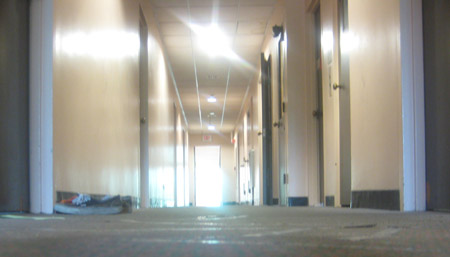
Harkness second floor hallway.
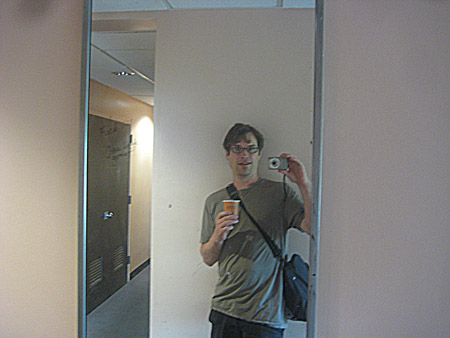
Me in the Harkness hallway mirror.
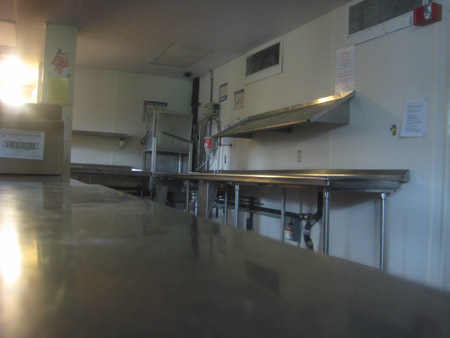
Harkness kitchen. The dishwasher has been moved six feet in the last 20 years.
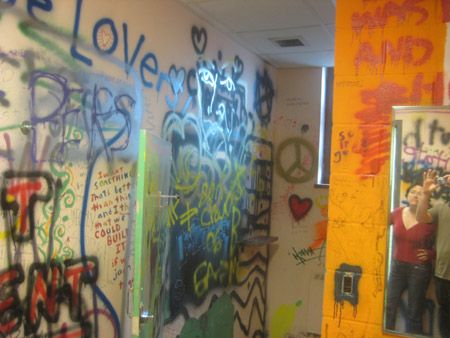
Graffiti in the basement "Hell Bathroom" of Harkness.
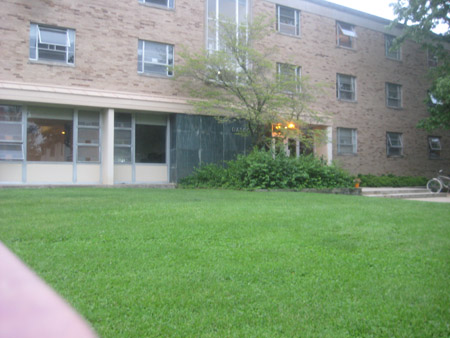
The ugliness of Dascomb.
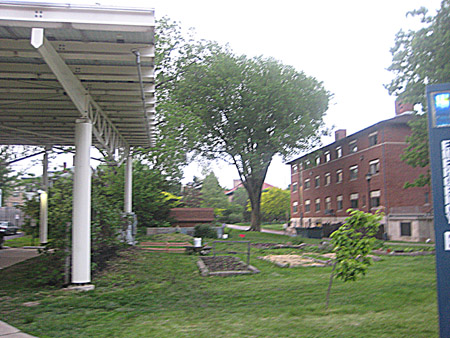
Behind Harkness. The big American Elm is still alive. The white thing in the left foreground is a massive photovoltaic array. There is also a garden plot here that might depend for its nutrients on sewage generated by the nearby Environmental Studies building.
For linking purposes this article's URL is:
http://asecular.com/blog.php?110527 feedback
previous | next |





